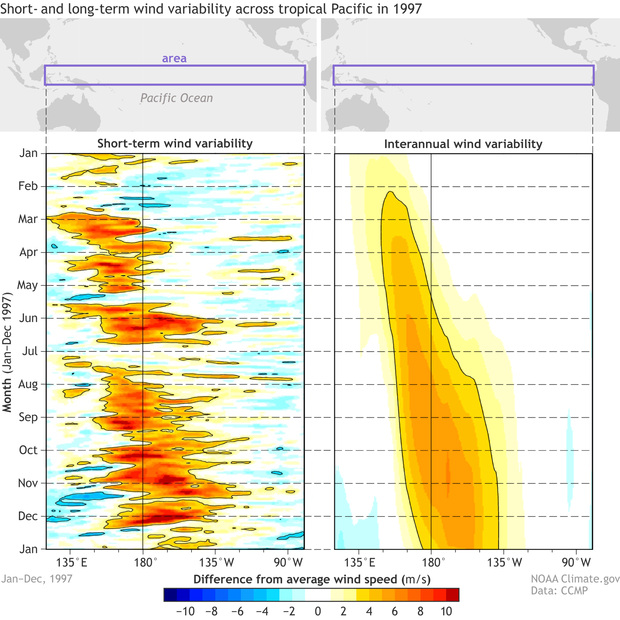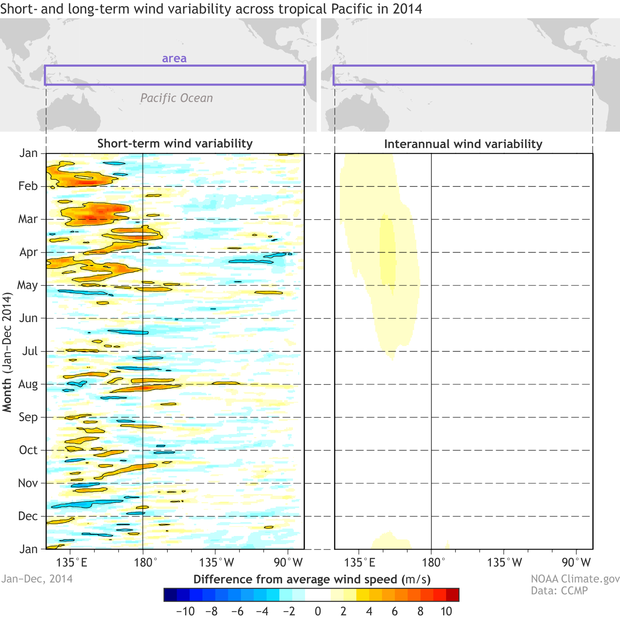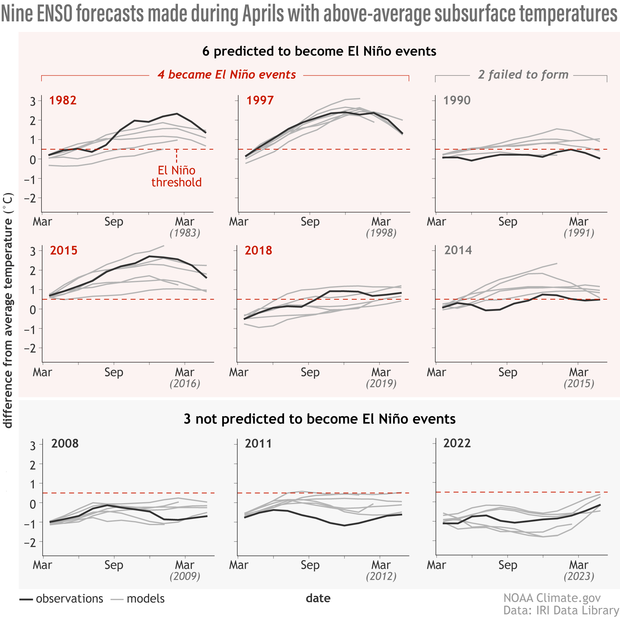May 9, 2023 - By Michelle L’Heureux - Given the relatively high probabilities for El Niño in our team’s April 2023 ENSO update, I decided to team up with some of my scientific colleagues, Antonietta Capotondi (NOAA Physical Sciences Laboratory and University of Colorado, Cooperative Institute for Research in Environmental Sciences) and Aaron Levine (@afzlevine, University of Washington, Cooperative Institute for Climate, Ocean, and Ecosystem Studies), to explain why making ENSO forecasts during the Northern Hemisphere springtime generally makes us want to skip the forecast. But we, of course, cannot because if a decent-sized El Niño is going to form, it is probably going to form in the spring or summer. Which means as much as we’d like to punt on ENSO forecasts in the spring, we have to issue Watches when the tropical Pacific starts pushing in that direction (as we recently did, footnote #1).
This is not the first blog rant post on the lower predictability of springtime ENSO forecasts (here, here, here). And it will probably not be our last! Researchers in the ENSO community are well aware of the forecasting challenges during the spring and are hard at work trying to better understand precursor patterns and fix model biases that may make it easier to predict ENSO in the future.
So, what’s the big deal in the spring? Especially when it comes to predictions of El Niño? It comes down to uncertainty in two of the main ingredients that give rise to El Niño.
- In the spring, it is difficult to know whether surface west-to-east (“westerly”) wind anomalies across the tropical Pacific Ocean will continue through the summer and persist long enough to reinforce the developing El Niño.
- The heat in the subsurface tropical Pacific Ocean is a necessary precursor for El Niño but it is not always sufficient.
Let’s focus on #1 first: the persistence of the surface winds. Dr. Capotondi has published research exploring the relationship of surface winds across the tropical Pacific with ENSO. She used a very detailed satellite-based wind dataset for her analysis and found that the interannual changes in the surface winds are the key ingredient for triggering El Niño (footnote #2). Without persistence of these tropical winds, many El Niño events struggle to achieve lift off and can fizzle. It is this interannual wind variability that determines whether you get a major El Niño (e.g. 1997-98) or an El Niño “bust” (e.g. 2014).
Let’s examine the figures below to visualize this. Starting in March 1997, westerly wind anomalies (warm colors) began to form over the western tropical Pacific Ocean (left panel). In the 1997 case, the interannual variability in the winds (middle panel) was especially strong and long lasting, extending over a year and shifting very gradually eastward with time. A major El Niño event formed and peaked during the 1997-98 winter.
During 1997, the evolution of the surface zonal wind anomalies (in meters per second) along the equatorial Pacific Ocean. Red shading indicates anomalous westerly (from the west) winds, while blue shading denotes anomalous easterly winds. The left panel emphasizes winds that are relatively short-term (the filter isolates periods more than 5 days). The right panel emphasizes the “interannual” winds that are longer-term and more persistent (the filter isolates periods greater than 250 days). On average, the surface winds across the tropical Pacific are easterly, so westerly anomalies—departures from average conditions—can weaken the Walker Circulation. But only if they persist do they lead to El Niño. See Capotondi et al. (2018) for more details on the calculation and data. Figure provided by Antonietta Capotondi and modified by Climate.gov.
Now let’s look at the same period of months during 2014, which, in the spring, was predicted to be a potentially major El Niño event. Right on cue, similar to 1997, the westerly wind anomalies began early in the calendar year and lasted through April (left panel below). However, for some unknown reason, the westerly winds began dissipating and the interannual wind variability was very weak-to-nonexistent for the rest of 2014 (middle panel below).
During 2014, the evolution of the surface zonal wind anomalies (in meters per second) along the equatorial Pacific Ocean. Red shading indicates anomalous westerly (from the west) winds, while blue shading denotes anomalous easterly winds. The left panel emphasizes winds that are relatively short-term (the filter isolates periods more than 5 days). The right panel emphasizes the “interannual” winds that are longer-term and more persistent (the filter isolates periods greater than 250 days). On average, the surface winds across the tropical Pacific are easterly, so westerly anomalies—departures from average conditions—can weaken the Walker Circulation. But only if they persist do they lead to El Niño. See Capotondi et al. (2018) for more details on the calculation and data. Figure provided by Antonietta Capotondi and modified by Climate.gov.
Bottom line: if the surface westerly wind anomalies fizzle out and do not continue to recur and intensify throughout the year (the interannual variability), then El Niño can similarly fail to get going. Unfortunately, we can only see this interannual wind variability after the year is over (and we are looking back at the previous year). In the midst of the spring/summer, we do not know whether these winds are random-random or are going-somewhere-random (they are considered mostly forecastable out to 7-10 days). Not ideal, we know.
This brings us to #2: The presence of above-average oceanic heat in the tropical Pacific Ocean. Dr. Levine recently started a 3-year NOAA Climate Program Office (CPO) funded research project on the topic of El Niño false alarms, which are El Niño events that were confidently predicted to happen, but then failed to do so for some mysterious reason. Dr. Levine provided the figure below which displays the many different climate forecasting models that are part of the North American Multi-Model Ensemble (NMME).
Model forecasts (light gray lines: means from the North American Multi-model Ensemble) and observations (black lines: ERSSTv5 temperature data) of ENSO as measured by the Niño-3.4 index. Years are selected based on the nine largest April values of subsurface warm water volume anomalies (0-500 meters below the surface) of the tropical Pacific Ocean (120E-80W). Subsurface data based on TAO buoys. Figure provided Aaron Levine and modified by Climate.gov.
Each panel in the figure shows 9 different ENSO forecasts made during the month of April. These forecasts all have one major thing in common, which is the presence of above-average temperatures within the subsurface (0-500 meters below the surface) of the tropical Pacific Ocean (footnote #3). The majority, or 6 of the 9 April forecasts, had elevated chances of El Niño events developing later in the year. Another way to express this is that enhanced oceanic heat in the spring can make it more likely an El Niño could form, but it’s not a guarantee either.
Now let’s look closer at those 6 April forecasts that were predicted to become El Niño events (1982, 1990, 1997, 2014, 2015, 2018). Out of that group, 4 of the 6 became El Niño events and 2 failed to form (1990, 2014). Interestingly, of the ones that became El Niño events, the ultimate strength was mostly underestimated, meaning that the El Niños ended up becoming stronger in the winter than the majority of model ensembles predicted in April. So, while bust potential is a risk, there is also limited evidence that models can still be somewhat conservative with forecasting peak intensity!
On the net, while the tropical Pacific precursors of El Niño are currently evident this spring, there is a certain amount of forecast uncertainty that will not go away. Come this summer/fall, we will see whether the conditions we’re seeing this spring were, in fact, sufficient to become a bona fide El Niño (and potentially a significant one). Watch this space.
Footnotes
(1) So, if spring forecasting is such a challenge, then why do the current probabilities seem so high? As Emily laid out in her recent blog post and in the official ENSO discussion, we are currently seeing some of the required precursors of El Niño: (a) recurrence of westery wind anomalies across the equatorial Pacific and (b) emergence of above-average ocean heat content. Morever, many of the state-of-the-art climate models we consider (such as those in the NMME) are providing peak chances of El Niño in excess of 90%. However, because we know the objective model guidance tends to be overconfident this time a year (here and here), the chances in the official outlook are slightly lower (peaking in the mid-80%).
(2) What are these interannual winds? Interannual in our lingo are the “year-to-year” changes. Retrospectively, we can examine the part of the winds that were the most persistent, lasting over a span of at least 8 months (greater than 250 days in this study).
(3) Aaron is examining the 9 cases with the largest April tropical Pacific subsurface ocean heat content anomalies since 1980 via the NOAA PMEL website showing measurements from the TAO buoys.
A blog about monitoring and forecasting El Niño, La Niña, and their impacts.
Disclaimer:
The ENSO blog is written, edited, and moderated by Michelle L’Heureux (NOAA Climate Prediction Center), Emily Becker (University of Miami/CIMAS), Nat Johnson (NOAA Geophysical Fluid Dynamics Laboratory), and Tom DiLiberto and Rebecca Lindsey (contractors to NOAA Climate Program Office), with periodic guest contributors.
Ideas and explanations found in these posts should be attributed to the ENSO blog team, and not to NOAA (the agency) itself. These are blog posts, not official agency communications; if you quote from these posts or from the comments section, you should attribute the quoted material to the blogger or commenter, not to NOAA, CPC, or Climate.gov.
Source: ENSO blog team











